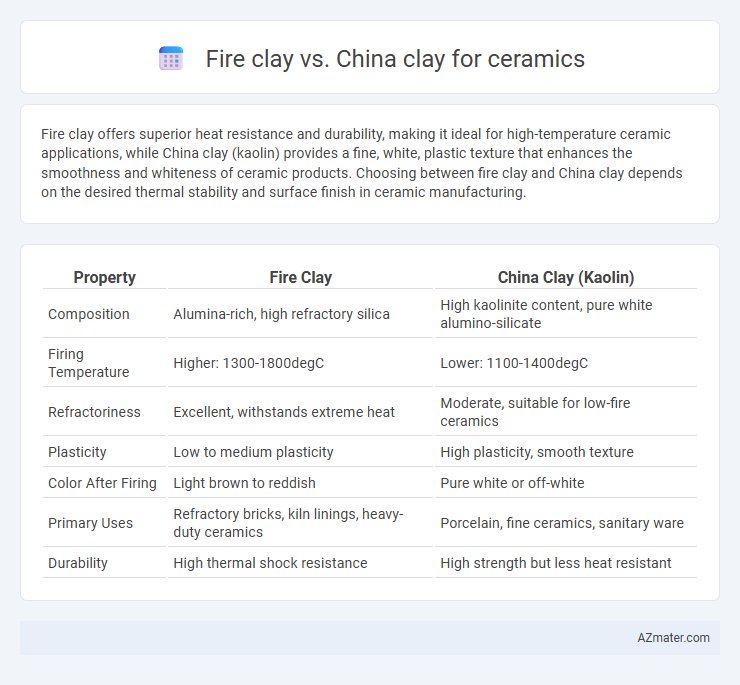Fire clay offers superior heat resistance and durability, making it ideal for high-temperature ceramic applications, while China clay (kaolin) provides a fine, white, plastic texture that enhances the smoothness and whiteness of ceramic products. Choosing between fire clay and China clay depends on the desired thermal stability and surface finish in ceramic manufacturing.
Table of Comparison
| Property | Fire Clay | China Clay (Kaolin) |
|---|---|---|
| Composition | Alumina-rich, high refractory silica | High kaolinite content, pure white alumino-silicate |
| Firing Temperature | Higher: 1300-1800degC | Lower: 1100-1400degC |
| Refractoriness | Excellent, withstands extreme heat | Moderate, suitable for low-fire ceramics |
| Plasticity | Low to medium plasticity | High plasticity, smooth texture |
| Color After Firing | Light brown to reddish | Pure white or off-white |
| Primary Uses | Refractory bricks, kiln linings, heavy-duty ceramics | Porcelain, fine ceramics, sanitary ware |
| Durability | High thermal shock resistance | High strength but less heat resistant |
Introduction to Fire Clay and China Clay
Fire clay, a highly refractory material composed mainly of kaolinite and alumina, offers excellent heat resistance making it ideal for high-temperature ceramics and kiln linings. China clay, also known as kaolin, is a fine, white mineral primarily used to enhance the plasticity and whiteness of ceramics, contributing to the smooth texture and strength of porcelain and fine china. Both materials hold distinct roles in ceramic manufacturing, where fire clay provides thermal durability while china clay improves workability and aesthetic quality.
Chemical Composition Comparison
Fire clay primarily consists of kaolinite with high alumina (Al2O3) content around 30-40% and significant silica (SiO2) ranging from 45-55%, providing exceptional high-temperature resistance. China clay, also known as kaolin, contains higher purity kaolinite with alumina content typically 38-40% and silica levels about 45-50%, but with fewer impurities like iron oxide and alkalis. The chemical composition difference influences their plasticity, firing temperature, and final ceramic properties, making fire clay ideal for refractory ceramics and china clay suitable for fine whiteware and porcelain.
Physical Properties: Texture and Color
Fire clay features a dense, coarse texture with a reddish to brownish hue, providing excellent refractory properties ideal for high-temperature ceramics. China clay, also known as kaolin, exhibits a fine, smooth texture with a bright white color, enhancing whiteness and translucency in ceramic products. The contrasting physical properties affect their suitability; fire clay's coarse grains add strength and thermal resistance, while china clay's purity and whiteness improve surface finish and whiteness.
Sources and Geographical Availability
Fire clay, a refractory material rich in alumina and silica, primarily originates from sedimentary deposits found in regions like the Appalachian Basin in the United States, the UK, and parts of India, making it abundant in areas with coal and shale formations. China clay, also known as kaolin, is predominantly sourced from highly weathered granite formations and is extensively mined in China, the United States (notably in Georgia), and Brazil, contributing to its global availability for fine ceramic production. The geographical distribution of fire clay and china clay significantly influences their accessibility and cost in the ceramic manufacturing industry.
Firing Temperature Differences
Fire clay withstands higher firing temperatures, ranging between 1200degC to 1600degC, making it ideal for stoneware and porcelain production. China clay, or kaolin, typically fires at lower temperatures from 1100degC to 1400degC, suitable for fine white ceramics like china and porcelain. The higher refractory nature of fire clay provides better thermal stability during high-temperature firings compared to china clay.
Workability in Ceramic Processes
Fire clay exhibits superior workability in ceramic processes due to its high plasticity and resistance to thermal shock, making it ideal for products requiring durability and heat resistance. China clay, or kaolin, has lower plasticity but provides excellent whiteness and smoothness, enhancing the surface finish of ceramics while requiring careful moisture control during shaping. Optimizing the blend of fire clay and china clay can balance workability and fired properties, improving moldability and final product strength.
Role in Glaze and Body Formulations
Fire clay enhances ceramic body durability and thermal resistance, crucial for high-temperature firing processes and improving glaze adherence by providing a stable, refractory base. China clay, or kaolin, contributes to glaze formulation by imparting whiteness, smooth texture, and plasticity, resulting in a refined surface and improved glaze fit on porcelain bodies. Both clays optimize the balance between ceramic body strength and glaze quality, with fire clay emphasizing refractory properties and china clay focusing on aesthetic and textural enhancements.
Strength and Durability Outcomes
Fire clay exhibits superior strength and durability compared to china clay when used in ceramics due to its high alumina content and resistance to thermal shock. The dense, refractory nature of fire clay enhances the mechanical properties of ceramic products, making them suitable for heavy-duty applications such as kiln linings and industrial ceramics. In contrast, china clay, primarily composed of kaolinite, offers finer plasticity and whiteness but provides less structural strength and lower resistance to high temperatures and wear.
Typical Ceramic Applications
Fire clay is commonly used in ceramic applications that require high thermal resistance, such as kiln furniture, refractory bricks, and oven linings, due to its ability to withstand temperatures above 1500degC. China clay, also known as kaolin, is primarily utilized in the production of porcelain, fine ceramics, and sanitary ware because of its whiteness, plasticity, and purity, which contribute to smooth surfaces and delicate finishes. Typical ceramic applications leverage fire clay's durability for structural components, while china clay is favored for aesthetic and functional qualities in tableware and decorative ceramics.
Cost and Environmental Considerations
Fire clay, known for its higher refractory properties, typically costs more than China clay due to its complex mining and processing requirements. China clay, or kaolin, is more abundant and less energy-intensive to process, resulting in lower overall costs and a smaller environmental footprint. Choosing fire clay increases durability in ceramics but involves greater environmental impact and expense compared to the more eco-friendly and economical China clay.

Infographic: Fire clay vs China clay for Ceramic
 azmater.com
azmater.com